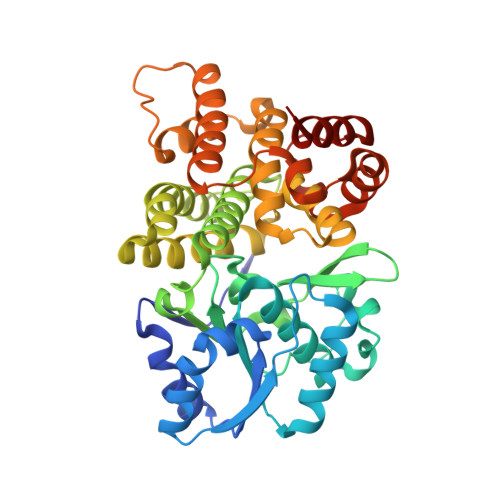Crystal structures and kinetic studies of a laboratory evolved aldehyde reductase explain the dramatic shift of its new substrate specificity.
Sridhar, S., Zavarise, A., Kiema, T.R., Dalwani, S., Eriksson, T., Hajee, Y., Reddy Enugala, T., Wierenga, R.K., Widersten, M.(2023) IUCrJ 10: 437-447
- PubMed: 37261425
- DOI: https://doi.org/10.1107/S205225252300444X
- Primary Citation of Related Structures:
7QLG, 7QLQ, 7QLS, 7QNH - PubMed Abstract:
The Fe 2+ -dependent E. coli enzyme FucO catalyzes the reversible interconversion of short-chain (S)-lactaldehyde and (S)-1,2-propanediol, using NADH and NAD + as cofactors, respectively. Laboratory-directed evolution experiments have been carried out previously using phenylacetaldehyde as the substrate for screening catalytic activity with bulky substrates, which are very poorly reduced by wild-type FucO. These experiments identified the N151G/L259V double mutant (dubbed DA1472) as the most active variant with this substrate via a two-step evolutionary pathway, in which each step consisted of one point mutation. Here the crystal structures of DA1472 and its parent D93 (L259V) are reported, showing that these amino acid substitutions provide more space in the active site, though they do not cause changes in the main-chain conformation. The catalytic activity of DA1472 with the physiological substrate (S)-lactaldehyde and a series of substituted phenylacetaldehyde derivatives were systematically quantified and compared with that of wild-type as well as with the corresponding point-mutation variants (N151G and L259V). There is a 9000-fold increase in activity, when expressed as k cat /K M values, for DA1472 compared with wild-type FucO for the phenylacetaldehyde substrate. The crystal structure of DA1472 complexed with a non-reactive analog of this substrate (3,4-dimethoxyphenylacetamide) suggests the mode of binding of the bulky group of the new substrate. These combined structure-function studies therefore explain the dramatic increase in catalytic activity of the DA1472 variant for bulky aldehyde substrates. The structure comparisons also suggest why the active site in which Fe 2+ is replaced by Zn 2+ is not able to support catalysis.
- Department of Chemistry - BMC, Uppsala University, SE-751 23 Uppsala, Sweden.
Organizational Affiliation:



















